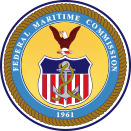Statement of Commissioner Rebecca Dye Federal Maritime Commission Supply Chain Innovation Teams Senate Committee on Commerce, Science, and Transportation Subcommittee on Surface Transportation and Merchant Marine Infrastructure, Safety and Security
Chairman Fischer, Ranking Member Booker, and Members of the Subcommittee, thank you for the opportunity to appear before you today on behalf of the members of the Federal Maritime Commission Supply Chain Innovation Teams.
To accompany my statement, I submitted a list of the companies represented on our Innovation Teams, and the port directors, business and academic advisors, and trade association consultants who have supported the initiative.
I’d like to take the opportunity to publicly thank the talented individuals (and their companies) who volunteered their time and resources to advance this project.
How to Add Value to Supply Chain Debate
After issuing a report in 2015 on the results of the port congestion and supply chain forums the Commission held at ports around the country, we asked ourselves: Should the Commission become more involved in international supply chain challenges? And if so, how could we add value?
Why the Federal Maritime Commission
As you know, the Commission has broad statutory authority over international ocean carriers, ports, marine terminals, and ocean transportation intermediaries. As a result of our work with them, we understand the commercial realities our stakeholders face.
The overall goal of the Commission’s competition enforcement program under the Shipping Act of 1984 is to provide competitive ocean transportation rates and service for American exporters and importers, ultimately to the benefit of American consumers.
Our programmatic responsibilities give us a vital perspective on the international supply chain challenges of American exporters and importers.
No Additional Government Regulation
We concluded that the Commission could “add value” and help address the challenges of America’s international supply chain, but rejected the idea that the performance of the commercial supply chain would be improved by additional government regulation.
Nor would we look over the shoulders of port officials and attempt to duplicate or second-guess the tough decisions they are making to combat supply chain problems.
Team Work and Process Innovation
The approach we adopted for this initiative is built on two concepts: small team work and process innovation.
We heard from industry groups that many business leaders were anxious to “roll up their sleeves” and actively engage “across the table” to address end-to-end global supply chain issues together.
To respond to this desire for active engagement, we organized smalls teams of industry leaders representing key supply chain industries: ocean carriers, U.S. ports, marine terminal operators, warehouse operators, chassis providers, longshore labor, trucking, railroads, intermediaries, and American exporters and importers.
Second, we directed our teams to focus on “actionable” process innovation. We asked them to “step out of their business silos” and identify one key process innovation that would improve overall international supply chain reliability and resilience.
Innovation Teams Recommendation
At the launch of our Supply Chain Innovation Teams initiative last May, our three teams quickly identified supply chain visibility as one of the most effective ways to increase supply chain performance.
Integrated information systems provide supply chain visibility that encourages businesses to act in a more coordinated and effective way.
National Seaport Information Portal
Our Innovation Teams identified the development of a national seaport information portal as the one process innovation that could be adapted for use by ports around the United States.
Our import teams developed standardized information for each actor in the international import supply chain and determined when that information should be made available.
In July, our export teams will begin developing standardized information for our export supply chain.
Port Director Interviews
Collateral benefits of our initiative include the insights team members have gained into the business realities of other actors in the supply chain system.
We have also gained great insights into the strengths of U.S. ports from interviews we have organized with ten directors of major container ports on the East Coast, West Coast, and Gulf Coast.
Their professionalism, dedication, and commitment was impressive.
Information Infrastructure Key to American Economic Competitiveness
Chairman Fischer, we believe that information infrastructure that will increase the performance of our country’s international supply chain is key to America’s economic competitiveness.
We have suggested to you legislative authority for the Commission to develop a demonstration project for a national seaport information portal.
We do not recommend that the Federal government build or maintain a national seaport information system. However, while our teams are intact and available for consultation, we believe that the time is right to take the next step and test the concept of a national seaport information portal.
Thank you, Chairman Fischer and Members of the Subcommittee. I’m pleased to answer your questions.

